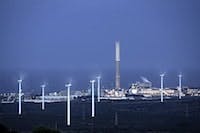Envirogen Technologies Inc. has entered into a collaborative alliance with Suez Environnement and will work with the company to deliver comprehensive, cost-effective water and wastewater treatment solutions to the power industry in North America.
Effective immediately, the two companies will collaborate exclusively to pursue and execute major environmental projects for electrical power generation facilities, with each company contributing proprietary technology and experience in developing high-performing, low lifecycle cost solutions. The alliance will combine Suez Environnement’s capabilities in physical/chemical treatment technologies with Envirogen’s expertise in biological treatment, but can extend to include the breadth of the technology portfolios of both companies. Near-term project targets for the alliance include groundwater and landfill leachate treatment related to coal combustion residuals (CCR), and flue-gas desulfurization (FGD) wastewater treatment. Both of these areas will be governed by new U.S. federal regulations coming online in the next 48 months.
The U.S. Environmental Protection Agency is revising the Clean Water Act’s Effluent Limitation Guidelines for the steam electric power industry that will change how many power plants manage and treat wastewater in the U.S. New regulations that cover flue gas desulfurization wastewater are expected to be implemented for more than 200 U.S coal-burning power plant facilities. It is expected that contaminants such as mercury, arsenic and selenium will be regulated to low levels at these facilities. At the same time, new regulations are being implemented on CCRs, commonly known as coal ash, that are disposed of at large surface impoundments and landfills. These residuals contain contaminants like selenium, mercury, cadmium and arsenic. In both cases, treatment will require a range of processes that include both physical/chemical and biological technologies.
Recent work in the mining industry and significant pilot tests in the power industry have shown that biological treatment is often the highest performing, most reliable and least cost solution in treating selenium, nitrate and other oxyanions that are at the heart of some of the new power industry regulations. Envirogen has experience in biological treatment, with numerous installations of its fluidized bed reactor (FBR) technology in North America. This track record includes compelling performance and economic advantages in commercial installations and pilot work in treating selenium at coal mines. The ability to reliably remove selenium, other metals and nitrate to very low levels will be critical to helping the power industry meet their regulatory goals as the new FGD and CCR regulations come online.
“The waste streams that are present in the power industry are incredibly complex and differ from site to site. It’s important that the best technology, tailored in multi-component solutions is brought to bear to meet treatment requirements cost effectively,” said Richard Reese, president and CEO of Envirogen. “Suez Environnement has an incredibly broad technology portfolio and experience base in the power industry and can help realize the potential of biological technology in these applications.”
Source: Envirogen Technologies Inc.


